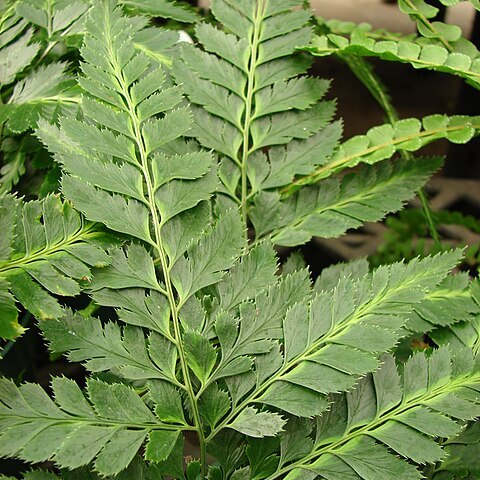Plants terrestrial, evergreen, medium-sized (or large). Rhizome long creeping to short and ascending, or rarely erect, densely scaly; scales filiform, subulate, lanceolate, or ovate, often attenuate toward apex, margin entire or with toothlike (rarely fimbriate) projections. Fronds few, remote or approximate; stipe equal in length to lamina or longer, base as densely scaly as rhizome, adaxially sulcate; lamina deltoid, ovate, pentagonal, or rarely lanceolate, usually 2-4(or 5)-pinnate, but simply pinnate in a few species, herbaceous, papery to leathery, glabrous or with a few narrow scales, rarely hairy; dissection anadromous throughout; rachis adaxially sulcate, grooves continuous with those on axes of higher order, scaly to glabrescent, or rarely with pale gray unicellular acicular hairs, scales entire (or with irregular projections on margin), sometimes with enlarged and denticulate base; pinnae a few to numerous pairs, usually shortly stalked, basal ones often with long basal basiscopic pinnules; upper divisions gradually reduced and ending in acuminate or caudate apices, or with a distinct terminal pinna; basiscopic pinnules often slightly longer than acroscopic ones; ultimate segments sessile, usually oblong to rhomboid, or rarely linear, often inequilateral, with an acroscopic auricle, margin sharply dentate to aristate; venation usually also anadromous, veins free, pinnate or forked, not quite reaching margin of ultimate segment, often ending in a hydathode. Sori orbicular, terminal or dorsal on acroscopic branches of veinlets; indusia orbicular-reniform, attached at a deep sinus, persistent or fugacious; sporangia numerous, long stalked, with an annulus of 13-16 thickened cells. Spores ellipsoid, often with broad rugate perispore. x = 41.
More
Plants terrestrial. Stems moderately long-to short-creeping, stolons absent. Leaves monomorphic, evergreen. Petiole ± as long as blade, base not swollen; vascular bundles more than 3, arranged in an arc, ± round in cross section. Blade broadly deltate or pentagonal, 2--3-pinnate-pinnatifid, gradually to abruptly reduced distally to pinnate or pinnatifid apex, papery to somewhat leathery. Pinnae not articulate to rachis, segment margins and especially apex spinulose; proximal pinnae largest, petiolulate, inequilateral with basal basiscopic pinnule much larger and more elongate than more distal pinnules; costae adaxially grooved, grooves continuous from rachis to costae to costules; indument of hairlike scales abaxially, absent adaxially. Veins free, forked. Sori in 1 row between midrib and margin, round; indusia round-reniform, attached at narrow sinus, persistent. Spores brownish, rugate or tuberculate, sometimes spiny. x = 41.
Terrestrial ferns. Rhizome creeping or suberect, scaly; scales non-peltate, non-clathrate, mostly entire, brown to red-brown. Fronds tufted or spaced. Stipe scaly. Lamina 2–4-pinnate, broadly deltoid to pentagonal, herbaceous to coriaceous; rachis ridges of the adaxial surface never continuous with the pinna margin; central channel scaly or glabrous. Ultimate segments with or without marginal teeth; veins free. Sori rounded, borne on the vein or at a vein tip; indusium rounded to reniform. Spores monolete, bilateral.

